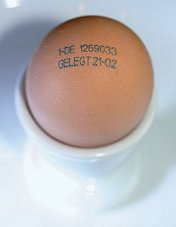Size, Shelf Life, and Code
Eggs have a minimum shelf life of 28 days, though in a commercial setting they must be refrigerated after the 18th day. The sale of eggs after 21 days is prohibited. The consumer can determine the date of laying by subtracting 28 days from the “sell-by” date printed on the egg, though the actual laying date is increasingly being voluntarily disclosed in the printed legend (Fig. 1).

Figure 1. Soft-boiled egg in an egg cup with typical German commercial markings.
In 2007, 41.4 million German hens laid 11.8 billion eggs. 66.1 % of these were from hens confined to cages, 17 % were barn eggs, 15.3 % were free-range eggs or from hens managed under “ecologically sound” conditions, and 1.5 % fell into the newly-defined category “small-group husbandry” [1]. Since in 2007 the average per person consumption in Germany was 210 eggs, it was also necessary to import nearly 6 billion eggs, chiefly from the Netherlands.
Prior to packaging, eggs are examined by shining a light through them to ensure the integrity of their shells (“candling”), so that in retail trade only eggs certified as “Class A” can be offered for sale. With this quality control measure (which once actually did involve candles as the light source!) eggs are examined internally — now in a fully-automatic process — to identify flaws, including blood spots, so that the corresponding eggs can be rejected.
Referring once again to Germany, packaging must specify the number of eggs contained, the way the relevant laying hens were managed, and provide an identifying number for the site of packing, as well as information on:
Weight Class
- S (small, < 53 g)
- M (medium, 53–63 g)
- L (large, 63–73 g) or
- XL (extra large, > 73 g)
Minimum Shelf Life
Date up to when refrigerated (!) eggs can safely be consumed raw.
EU Code
An EU Code is stamped on every egg, as follows:
The first digit identifies the way the relevant laying hens were managed. (0 = ecologically sound conditions, 1 = free-range, 2 = barn eggs, 3 = caged conditions). Expansion to include the number “4” is currently under consideration as a way of identifying “highly-developed cages, or small-group management”.
Two-letter country codes come next; e.g., DE for Germany, NE for Netherlands, etc.
There will then be a seven-digit number which, in Germany, identifies first the state of origin (e.g., 01 = Schleswig-Holstein, 03 = Niedersachsen, 12 = Brandenburg), followed by digits 3–6 to indicate a specific farm, and a seventh digit for a particular location on that farm.
References
[1] http://www.deutsche-eier.info/das-ei/eiermarkt/
- back to the Boiled Eggs: Soft and Hard – Part 1 article




